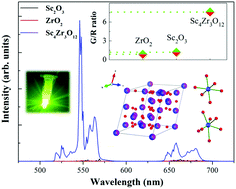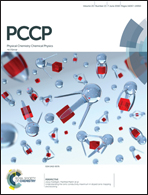Highly efficient upconversion emission of Er3+ in δ-Sc4Zr3O12 and broad-range temperature sensing†
Abstract
Developing optical temperature sensors with a wider range, higher sensitivity and repeatability based on Er3+/Yb3+ doped upconverting phosphors has always been at the forefront of temperature measurement technologies. Here, we report the intense green upconversion luminescence in Er3+/Yb3+ doped δ-Sc4Zr3O12 for the first time and its temperature sensing performance is investigated. The structure of δ-Sc4Zr3O12 is given by Rietveld refinement of XRD data and the site occupancy of Er3+ ions has been determined. Compared with cubic Sc2O3 and ZrO2, under 972 nm excitation, the green emission from Er3+ centers in Sc4Zr3O12 is increased by 59-fold and 264-fold, respectively. By experimental analysis, this enhancement of upconversion luminescence is attributed to the low-symmetrical environment of Er3+, generation of Yb3+ clusters and high internal efficiency of Yb3+ emission in Sc4Zr3O12. In addition, the fluorescence intensity ratio of two green emission bands (2H11/2/4S3/2 → 4I15/2) is studied as a function of temperature ranging from 303 to 793 K in Sc4Zr3O12. The maximum sensitivity observed via calculation is 0.00634 K−1 at 573 K, and the sensitivity is still as high as 0.00534 K−1 at 793 K. The stability of a Sc4Zr3O12 thermometer is also examined via a recycling test. These findings suggest that δ-Sc4Zr3O12 is a promising upconversion host and could achieve high-sensitivity optical temperature sensing with a wide measuring range.

- This article is part of the themed collection: 2018 PCCP HOT Articles


 Please wait while we load your content...
Please wait while we load your content...